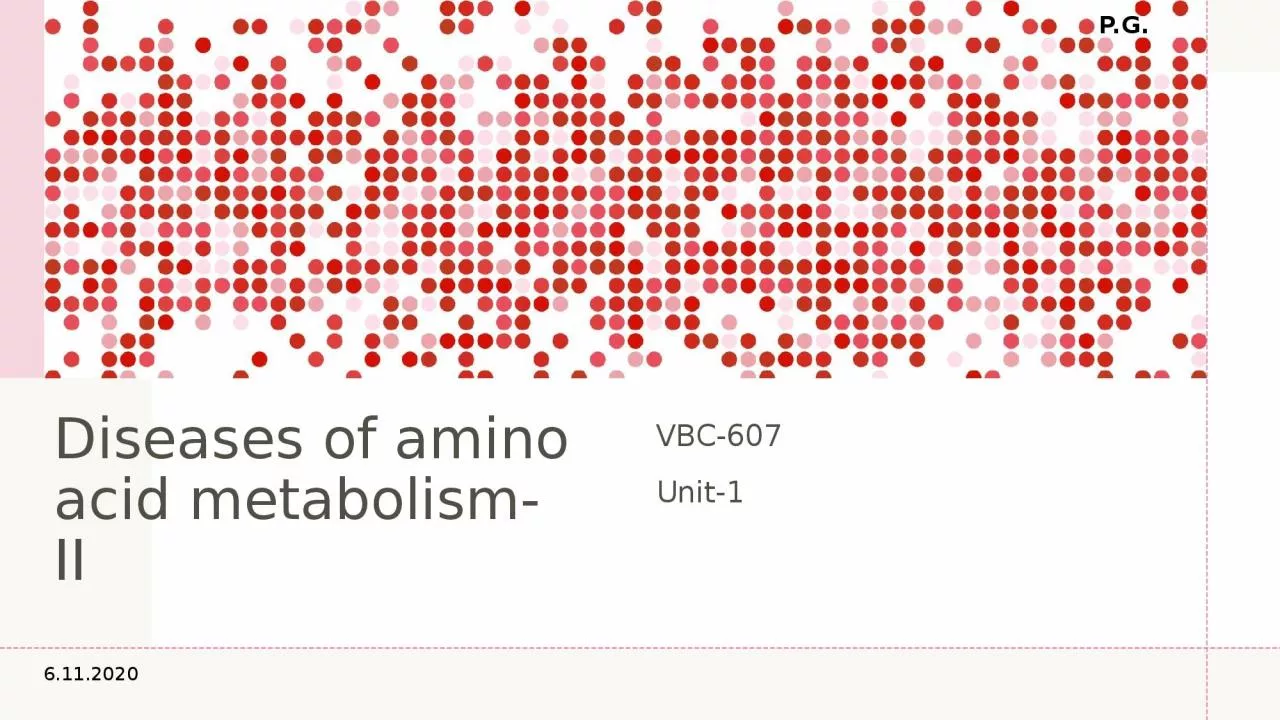

VBC607 Unit1 PG 6112020 MAPLE SYRUP URINE DISEASE Also known as Branched chain ketonuria Partial or complete deficiency of branchedchain α keto acid dehydrogenase a multienzyme complex associated with inner membrane of mitochondrion ID: 918861
Download Presentation The PPT/PDF document "Diseases of amino acid metabolism- II" is the property of its rightful owner. Permission is granted to download and print the materials on this web site for personal, non-commercial use only, and to display it on your personal computer provided you do not modify the materials and that you retain all copyright notices contained in the materials. By downloading content from our website, you accept the terms of this agreement.
Slide1
Diseases of amino
acid metabolism- II
VBC-607
Unit-1
P.G.
6.11.2020
Slide2MAPLE SYRUP URINE DISEASEAlso known as Branched chain ketonuriaPartial or complete deficiency of branched-chain α keto acid dehydrogenase (a multienzyme complex associated with inner membrane of mitochondrion)The enzyme complex that decarboxylate Leucine, Isoleucine and ValineAccumulation of-keto acids and hydroxy acids (especially leucine ) in blood and urinePhysical and mental retardation of newbornDistinct maple syrup or burnt sugar odour in urine, breath and skin
Slide3BCAT: Branched chain aminotransferaseBCKDH: branched chain keto acid dehydrogenaseIVD: iso valeric acid dehydrogenaseSBCAD: Short/branched chain acyl-CoA dehydrogenaseIBDH: Isobutyric acid dehydrogenase
Slide4Branched chain AA and their metabolic products (α- keto acids) accumulate in the blood, CSFLeads to toxic effect that interferes with neurologic changes and brain functions, including seizures and mental retardation
Slide5SymptomsLoss of appetiteFussinessSweet-smelling urineFeeding problemsVomitingDehydrationSevere metabolic acidocisPhysical disabilities and even death
Slide6TreatmentTreatment involved dietary restriction of the amino acids leucine, isoleucine, and valineSupplementation of high doses of thiamine pyrophosphatePatients can be treated with I/v infusion that helps the body use up excess leucine, isoleucine, and valine for protein synthesis.Gene therapy is also a potential future treatment for patients with MSUD. This treatment would involve replacing the mutated gene with a good copy, allowing the patient's cells to make a functional BCKD protein complex and break down the excess amino acids
Slide7ALBINISMA group of inherited disorders that results in little or no production of the pigment melaninLack of tyrosinaseA marked lack of pigmentationSensitive to damage from sunlight and must take added precaution against UV radiationNormal eyesightNo neurologic deficits
Slide8Tyrosine hydroxylase and aromatic amino acid decarboxylase deficiencies: Inherited causes of impaired biogenic amine metabolism
Slide9Two main types of albinism - characterized by the areas affected by the abnormality:1. Oculotaneous albinism and 2. Ocular albinism.1. Oculotaneous albinism describes a phenotype that lacks pigment in the skin, hair, and eyes.2. Ocular albinism occurs when the phenotype only lacks pigment from the eyes, the hair and skin appear normal in these individuals.Among the two types, oculotaneous albinism is typically more prominent
Slide10Methyl Malonic AciduriaA classical type of organic acidemiaCondition is the inability to properly digest specific fats and proteinsLeads to a buildup of a toxic level of methylmalonic acid in the bloodAn autosomal recessive disorder of amino acid metabolism, involving a defect in the conversion of methylmalonyl-coenzyme A (CoA) to succinyl-CoA
Slide11SymptomsNeurologic manifestations, such as seizure, encephalopathy, and strokeSeveral cases have involved strokeTreatmentProtein-restricted diet- decreases the key amino acids (eg, isoleucine, valine, threonine, methionine)Cobalamin supplementation- a cofactor in the enzymatic conversion of methylmalonyl-coenzyme A (CoA) to succinyl-CoA.L-carnitine- involved in the metabolism of long-chain fatty acids, buffers the acyl-CoA metabolitesLiver transplantation alone or in conjunction with kidney transplantation has been attempted
Slide12Homocystinuriadisorder of the metabolism of the amino acid methionineDue to the defect in the enzyme Cystathionine β–synthase which converts Homocysteine to CystathionineLeads to accumulation of homocysteine and other toxins that damage the nervous system, which includes the brain, and the vascular system
Slide13Symptomsdislocation of the lenses in the eyesnearsightednessabnormal blood clotsosteoporosis, or weakening of the boneslearning disabilitieschest deformities, such as a protrusion or a caved-in appearance of the breastbonelong, spindly arms and legsscoliosis
Slide14TreatmentHigh doses of vitamin pyridoxineA diet low in the amino acid methionine (sulphur containing amino acid)Betaine is a nutrient that works to remove homocysteine from the blood. Taking a folic acid supplement and adding the amino acid cysteine to the diet are helpful
Slide15Hartnup’s diseaseAlso known as Pellagra-like dermatosisAbsorption of nonpolar amino acids (particularly tryptophan) intestine& kidney is impaired
Slide16Symptomssensitivity to lightanxietyhallucinationsdelusionstremorabnormalities in muscle tone: either muscles can become more tightTreatmentconsists of a change in diet, avoidance of sunlight, and prescribing sulfonamide drugsB-complex vitamin Niacin can significantly reduce symptoms.Good sources of niacin include: Meat, poultry, fish, fortified and whole grains B-complex or niacin vitamin supplements (such as nicatonic acid)